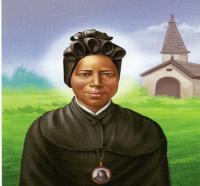
Feast day: 8 February
St Josephine Margaret Bakhita was born in 1869 in Darfur (now in western Sudan) in the village of Olgossa, west of Nyala and close to Mount Agilerei. She was one of the Daju people; her father was respected and fairly well off, and was the brother of the village chief. She was part of a loving family of three brothers and three sisters. She says in her autobiography: “I lived a very happy and carefree life, without knowing what suffering was.”
In 1877, when she was about eight, she was captured by Arab slave traders, who had abducted her elder sister two years earlier. She was forced to walk barefoot for about 970 kilometres to El Obeid; there she was bought by a rich Arab, who used her as a maid for his two daughters. Bakhita was not her real name. The trauma of her abduction caused her to forget it. The new name which was given her means “lucky” or “fortunate” in Arabic. She was forced to convert to Islam.
She was treated well in her new situation until she offended one of the sons, who injured her so badly that she was unable to move from her straw bed for a month. She was sold again. Her fourth owner was a Turkish general. She had to serve his wife and her mother who were cruel to their slaves. “During the years I stayed in that house, I do not recall a day that passed without some wound or other. When a wound from the whip began to heal, other blows would pour down on me.” The most terrifying process was a traditional practice in Sudan, where she was cut with a razor in patterns marked by flour, the cuts being filled with salt to ensure permanent scarring.114 patterns were made into her body.
By 1882, El–Obeid was attacked; her owner prepared to return to his homeland and sold his slaves. Her new owner was the Italian Vice-Consul Callisto Legnani. He treated her kindly and at her request took her back to Italy with him. They travelled on a risky journey from Khartoum by camel to the port and embarked for Italy. Bakhita was given to a friend in the Veneto and became nanny to his daughter. She lived with them for three years before returning with them briefly to Sudan.
Augusto Michieli, her owner, acquired a large hotel in Sudan and decided to move his family there permanently. His wife joined him and left Josephine and his daughter with the Canossian nuns in Venice. Here she learnt about Christianity and found the God she had already discovered in her heart but had not named. When Maria Michieli returned to take her daughter and Josephine back to Sudan, she refused to go. Maria appealed to the attorney general of the King of Italy, while the superior of the Institute for Baptismal Candidates contacted the Patriarch of Venice. On 29 November 1889 an Italian court ruled that, because the British had outlawed slavery before Bakhita’s birth and because Italian law had never recognized slavery, Bakhita had never legally been a slave.
Bakhita chose to remain with the Canossian nuns. In 1890 she was baptised with the name Josephine Margaret Fortunata (translation of Bakhita) and received communion and confirmation from the Patriarch of Venice (later Pope Pius X). She entered the novitiate of the sisters and in 1896 took her vows, being welcomed by the Patriarch. In 1902 she was assigned to the Canossian convent at Schio, in the northern province of Vincenza, where she spent the rest of her life. Her only time away from the convent was between 1935 and 1939 when she stayed at the Missionary Novitiate in Virmecate (Milan), talking about her experiences and helping to prepare young sisters for work in Africa. She always felt drawn to missionary work and her heart was still in Africa.
During her 42 years in Schio, Bakhita was employed as cook, sacristan and portress, and was in frequent contact with the local community. Her serene manner, gentleness and good humour caused Vincenzans to remember her still as “Sor Moretta” (little brown sister) or “Madre Moretta” (black mother). She gained a reputation for sanctity within her order and her story, first told in 1931 by Ida Zanolini, entitled Storia Meravigliosa, made her famous throughout Italy. During the Second World War, the people felt protected by her presence, and though bombs fell on the city there were no casualties.
She suffered pain and sickness in her last years and was confined to a wheelchair. If asked how she was she would cheerfully reply, ”As the Master desires”. She saw her kidnapping as something positive because it had led her to Christianity. In her last hours her mind returned to her years of slavery and she cried out that the chains were too tight and asked that they would be loosened. She died on a Saturday, joyful that this was Mary’s day. Her last words were: “Yes, I am so happy - Our Lady — Our Lady.” She died on 8 February 1947. Thousands of people came to pay their respects. She was buried in the Church of the Holy Family of the Canossian convent of Schio.
The process for her canonization began twelve years after her death. Pope John Paul II visited Khartoum in 1993. He honoured Josephine with these words: “Rejoice, all of Africa. Bakhita has come back to you. The daughter of Sudan sold into slavery as a living piece of merchandise and yet still free: free with the freedom of the saints.” He canonized her in 2000.
St Josephine Bakhita, pray for us.